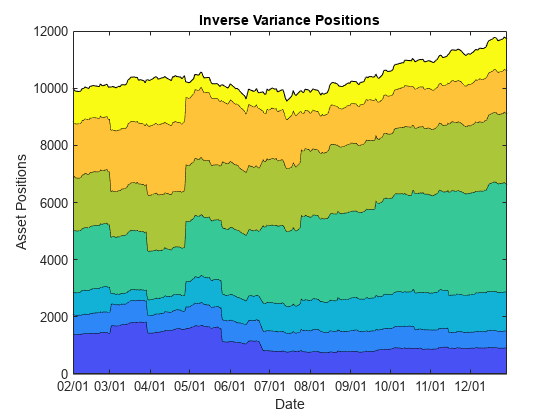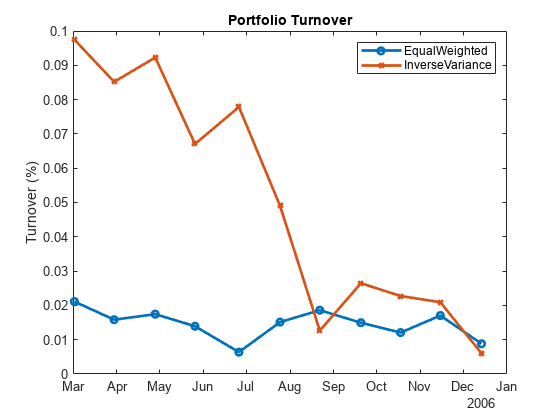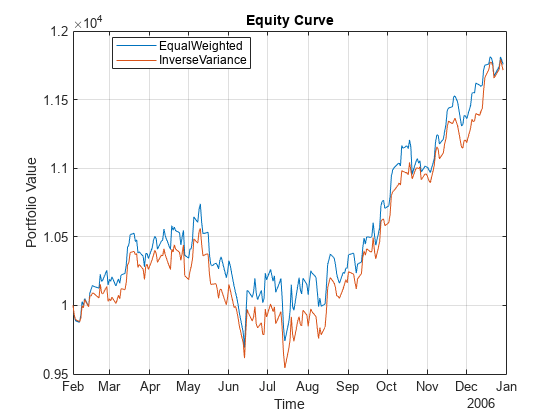summary
Generate summary table of backtest results
Description
summaryTable = summary(backtester)runBacktest function.
Examples
The MATLAB® backtesting engine runs backtests of portfolio investment strategies over time series of asset price data. You can use summary to compare multiple strategies over the same market scenario. This example shows how to examine the results of a backtest with two strategies.
Load Data
Load one year of stock price data. For readability, this example uses a subset of the DJIA stocks.
% Read table of daily adjusted close prices for 2006 DJIA stocks T = readtable('dowPortfolio.xlsx'); % Prune the table to include only the dates and selected stocks timeColumn = "Dates"; assetSymbols = ["BA", "CAT", "DIS", "GE", "IBM", "MCD", "MSFT"]; T = T(:,[timeColumn assetSymbols]); % Convert to timetable pricesTT = table2timetable(T,'RowTimes','Dates'); % View the final asset price timetable head(pricesTT)
Dates BA CAT DIS GE IBM MCD MSFT
___________ _____ _____ _____ _____ _____ _____ _____
03-Jan-2006 68.63 55.86 24.18 33.6 80.13 32.72 26.19
04-Jan-2006 69.34 57.29 23.77 33.56 80.03 33.01 26.32
05-Jan-2006 68.53 57.29 24.19 33.47 80.56 33.05 26.34
06-Jan-2006 67.57 58.43 24.52 33.7 82.96 33.25 26.26
09-Jan-2006 67.01 59.49 24.78 33.61 81.76 33.88 26.21
10-Jan-2006 67.33 59.25 25.09 33.43 82.1 33.91 26.35
11-Jan-2006 68.3 59.28 25.33 33.66 82.19 34.5 26.63
12-Jan-2006 67.9 60.13 25.41 33.25 81.61 33.96 26.48
The inverse variance strategy requires some price history to initialize, so you can allocate a portion of the data to use for setting initial weights. By doing this, you can "warm start" the backtest.
warmupRange = 1:20; testRange = 21:height(pricesTT);
Create Strategies
Define an investment strategy by using the backtestStrategy function. This example builds two strategies:
Equal weighted
Inverse variance
This example does not provide details on how to build the strategies. For more information on creating strategies, see backtestStrategy. The strategy rebalance functions are implemented in the Rebalance Functions section.
% Create the strategies ewInitialWeights = equalWeightFcn([],pricesTT(warmupRange,:)); ewStrategy = backtestStrategy("EqualWeighted",@equalWeightFcn, ... 'RebalanceFrequency',20, ... 'TransactionCosts',[0.0025 0.005], ... 'LookbackWindow',0, ... 'InitialWeights',ewInitialWeights)
ewStrategy =
backtestStrategy with properties:
Name: "EqualWeighted"
RebalanceFcn: @equalWeightFcn
RebalanceFrequency: 20
TransactionCosts: [0.0025 0.0050]
LookbackWindow: 0
InitialWeights: [0.1429 0.1429 0.1429 0.1429 0.1429 0.1429 0.1429]
ManagementFee: 0
ManagementFeeSchedule: 1y
PerformanceFee: 0
PerformanceFeeSchedule: 1y
PerformanceHurdle: 0
UserData: [0×0 struct]
EngineDataList: [0×0 string]
ivInitialWeights = inverseVarianceFcn([],pricesTT(warmupRange,:)); ivStrategy = backtestStrategy("InverseVariance",@inverseVarianceFcn, ... 'RebalanceFrequency',20, ... 'TransactionCosts',[0.0025 0.005], ... 'InitialWeights',ivInitialWeights)
ivStrategy =
backtestStrategy with properties:
Name: "InverseVariance"
RebalanceFcn: @inverseVarianceFcn
RebalanceFrequency: 20
TransactionCosts: [0.0025 0.0050]
LookbackWindow: [0 Inf]
InitialWeights: [0.1401 0.0682 0.0795 0.2187 0.1900 0.1875 0.1160]
ManagementFee: 0
ManagementFeeSchedule: 1y
PerformanceFee: 0
PerformanceFeeSchedule: 1y
PerformanceHurdle: 0
UserData: [0×0 struct]
EngineDataList: [0×0 string]
% Aggregate the strategies into an array
strategies = [ewStrategy ivStrategy];Run Backtest
Create a backtesting engine and run a backtest over a year of stock data. For more information on creating backtesting engines, see backtestEngine. The software initializes several properties of the backtestEngine object to empty. These read-only properties are populated by the engine after you run the backtest.
% Create the backtesting engine using the default settings
backtester = backtestEngine(strategies)backtester =
backtestEngine with properties:
Strategies: [1×2 backtestStrategy]
RiskFreeRate: 0
CashBorrowRate: 0
RatesConvention: "Annualized"
Basis: 0
InitialPortfolioValue: 10000
DateAdjustment: "Previous"
PayExpensesFromCash: 0
NumAssets: []
Returns: []
Positions: []
Turnover: []
BuyCost: []
SellCost: []
TransactionCosts: []
Fees: []
Run the backtest using runBacktest.
% Run the backtest
backtester = runBacktest(backtester,pricesTT(testRange,:));Examine Summary Results
The summary function uses the results of the backtest and returns a table of high-level results from the backtest.
s1 = summary(backtester)
s1=9×2 table
EqualWeighted InverseVariance
_____________ _______________
TotalReturn 0.17567 0.17155
SharpeRatio 0.097946 0.10213
Volatility 0.0074876 0.0069961
AverageTurnover 0.0007014 0.0024246
MaxTurnover 0.021107 0.097472
AverageReturn 0.00073178 0.00071296
MaxDrawdown 0.097647 0.096299
AverageBuyCost 0.018532 0.061913
AverageSellCost 0.037064 0.12383
Each row of the table output is a measurement of the performance of a strategy. Each strategy occupies a column. The summary function reports on the following metrics:
TotalReturn— The nonannulaized total return of the strategy, inclusive of fees, over the full backtest period.SharpeRatio— The nonannualized Sharpe ratio of each strategy over the backtest. For more information, seesharpe.Volatility— The nonannualized standard deviation of per-time-step strategy returns.AverageTurnover— The average per-time-step portfolio turnover, expressed as a decimal percentage.MaxTurnover— The maximum portfolio turnover in a single rebalance, expressed as a decimal percentage.AverageReturn—The arithmetic mean of the per-time step portfolio returns.MaxDrawdown— The maximum drawdown of the portfolio, expressed as a decimal percentage. For more information, seemaxdrawdown.AverageBuyCost— The average per-time-step transaction costs the portfolio incurred for asset purchases.AverageSellCost— The average per-time-step transaction costs the portfolio incurred for asset sales.
Sometimes it is useful to transpose the summary table when plotting the metrics of different strategies.
s2 = rows2vars(s1);
s2.Properties.VariableNames{1} = 'StrategyName's2=2×10 table
StrategyName TotalReturn SharpeRatio Volatility AverageTurnover MaxTurnover AverageReturn MaxDrawdown AverageBuyCost AverageSellCost
___________________ ___________ ___________ __________ _______________ ___________ _____________ ___________ ______________ _______________
{'EqualWeighted' } 0.17567 0.097946 0.0074876 0.0007014 0.021107 0.00073178 0.097647 0.018532 0.037064
{'InverseVariance'} 0.17155 0.10213 0.0069961 0.0024246 0.097472 0.00071296 0.096299 0.061913 0.12383
bar(s2.AverageTurnover) title('Average Turnover') ylabel('Average Turnover (%)') set(gca,'xticklabel',s2.StrategyName)

Examine Detailed Results
After you run the backtest, the backtestEngine object updates the read-only fields with the detailed results of the backtest. The Returns, Positions, Turnover, BuyCost, SellCost, and Fees properties each contain a timetable of results. Since this example uses daily price data in the backtest, these timetables hold daily results.
backtester
backtester =
backtestEngine with properties:
Strategies: [1×2 backtestStrategy]
RiskFreeRate: 0
CashBorrowRate: 0
RatesConvention: "Annualized"
Basis: 0
InitialPortfolioValue: 10000
DateAdjustment: "Previous"
PayExpensesFromCash: 0
NumAssets: 7
Returns: [230×2 timetable]
Positions: [1×1 struct]
Turnover: [230×2 timetable]
BuyCost: [230×2 timetable]
SellCost: [230×2 timetable]
TransactionCosts: [1×1 struct]
Fees: [1×1 struct]
Returns
The Returns property holds a timetable of strategy (simple) returns for each time step. These returns are inclusive of all transaction fees.
head(backtester.Returns)
Time EqualWeighted InverseVariance
___________ _____________ _______________
02-Feb-2006 -0.007553 -0.0070957
03-Feb-2006 -0.0037771 -0.003327
06-Feb-2006 -0.0010094 -0.0014312
07-Feb-2006 0.0053284 0.0020578
08-Feb-2006 0.0099755 0.0095781
09-Feb-2006 -0.0026871 -0.0014999
10-Feb-2006 0.0048374 0.0059589
13-Feb-2006 -0.0056868 -0.0051232
binedges = -0.025:0.0025:0.025; h1 = histogram(backtester.Returns.EqualWeighted,'BinEdges',binedges); hold on histogram(backtester.Returns.InverseVariance,'BinEdges',binedges); hold off title('Distribution of Daily Returns') legend([strategies.Name]);

Positions
The Positions property holds a structure of timetables, one per strategy.
backtester.Positions
ans = struct with fields:
EqualWeighted: [231×8 timetable]
InverseVariance: [231×8 timetable]
The Positions timetable of each strategy holds the per-time-step positions for each asset as well as the Cash asset (which earns the risk-free rate). The Positions timetables contain one more row than the other results timetables because the Positions timetables include initial positions of the strategy as their first row. You can consider the initial positions as the Time = 0 portfolio positions. In this example, the Positions timetables start with February 1, while the others start on February 2.
head(backtester.Positions.InverseVariance)
Time Cash BA CAT DIS GE IBM MCD MSFT
___________ ___________ ______ ______ ______ ______ ______ ______ ______
01-Feb-2006 0 1401.2 682.17 795.14 2186.8 1900.1 1874.9 1159.8
02-Feb-2006 0 1402.8 673.74 789.74 2170.8 1883.5 1863.6 1145
03-Feb-2006 0 1386.5 671.2 787.2 2167.3 1854.3 1890.5 1139
06-Feb-2006 1.0971e-12 1391.9 676.78 785.62 2161.1 1843.6 1899.1 1123.8
07-Feb-2006 0 1400 661.66 840.23 2131.9 1851.6 1902.3 1114.5
08-Feb-2006 -2.2198e-12 1409.8 677.9 846.58 2160.4 1878.2 1911 1113.2
09-Feb-2006 -2.2165e-12 1414.8 674.35 840.87 2172.2 1869 1908.3 1102.6
10-Feb-2006 0 1425.1 677.29 839.6 2195.8 1890.6 1909.3 1103.9
% Plot the change of asset allocation over time t = backtester.Positions.InverseVariance.Time; positions = backtester.Positions.InverseVariance.Variables; h = area(t,positions); title('Inverse Variance Positions'); xlabel('Date'); ylabel('Asset Positions'); xtickformat('MM/dd'); ylim([0 12000]) xlim([t(1) t(end)]) cm = parula(numel(h)); for i = 1:numel(h) set(h(i),'FaceColor',cm(i,:)); end

Turnover
The Turnover timetable holds the per-time-step portfolio turnover.
head(backtester.Turnover)
Time EqualWeighted InverseVariance
___________ _____________ _______________
02-Feb-2006 0 0
03-Feb-2006 0 0
06-Feb-2006 0 0
07-Feb-2006 0 0
08-Feb-2006 0 0
09-Feb-2006 0 0
10-Feb-2006 0 0
13-Feb-2006 0 0
Depending on your rebalance frequency, the Turnover table can contain mostly zeros. Removing these zeros when you visualize the portfolio turnover is useful.
nonZeroIdx = sum(backtester.Turnover.Variables,2) > 0; to = backtester.Turnover(nonZeroIdx,:); plot(to.Time,to.EqualWeighted,'-o',to.Time,to.InverseVariance,'-x',... 'LineWidth',2,'MarkerSize',5); legend([strategies.Name]); title('Portfolio Turnover'); ylabel('Turnover (%)');

BuyCost and SellCost
The BuyCost and SellCost timetables hold the per-time-step transaction fees for each type of transaction, purchases, and sales.
totalCost = sum(backtester.BuyCost{:,:}) + sum(backtester.SellCost{:,:});
bar(totalCost);
title('Total Transaction Costs');
ylabel('$')
set(gca,'xticklabel',[strategies.Name])
Generate Equity Curve
Use equityCurve to plot the equity curve for the equal weighted and inverse variance strategies.
equityCurve(backtester)

Rebalance Functions
This section contains the implementation of the strategy rebalance functions. For more information on creating strategies and writing rebalance functions, see backtestStrategy.
function new_weights = equalWeightFcn(current_weights, pricesTT) %#ok<INUSL> % Equal weighted portfolio allocation nAssets = size(pricesTT, 2); new_weights = ones(1,nAssets); new_weights = new_weights / sum(new_weights); end
function new_weights = inverseVarianceFcn(current_weights, pricesTT) %#ok<INUSL> % Inverse-variance portfolio allocation assetReturns = tick2ret(pricesTT); assetCov = cov(assetReturns{:,:}); new_weights = 1 ./ diag(assetCov); new_weights = new_weights / sum(new_weights); end
Input Arguments
Backtesting engine, specified as a backtestEngine object. Use
backtestEngine to create the
backtesting engine and then use runBacktest to run a
backtest.
Data Types: object
Output Arguments
Metrics summarizing the backtest, returned as a table where each row of the table is a calculated metric and each column represents a strategy. The reported metrics are as follows:
TotalReturn— The total return of the strategy over the entire backtestSharpeRatio— The Sharpe ratio for each strategyVolatility— The volatility of each strategy over the backtestAverageTurnover— Average turnover per-time-step as a decimal percentMaxTurnover— Maximum turnover in a single time stepAverageReturn— Average return per-time-stepMaxDrawdown— Maximum portfolio drawdown as a decimal percentAverageBuyCost— Average per-time-step transaction costs for asset purchasesAverageSellCost— Average per-time-step transaction costs for asset sales
Version History
Introduced in R2020b
See Also
backtestStrategy | backtestEngine | runBacktest | equityCurve
MATLAB Command
You clicked a link that corresponds to this MATLAB command:
Run the command by entering it in the MATLAB Command Window. Web browsers do not support MATLAB commands.
Web サイトの選択
Web サイトを選択すると、翻訳されたコンテンツにアクセスし、地域のイベントやサービスを確認できます。現在の位置情報に基づき、次のサイトの選択を推奨します:
また、以下のリストから Web サイトを選択することもできます。
最適なサイトパフォーマンスの取得方法
中国のサイト (中国語または英語) を選択することで、最適なサイトパフォーマンスが得られます。その他の国の MathWorks のサイトは、お客様の地域からのアクセスが最適化されていません。
南北アメリカ
- América Latina (Español)
- Canada (English)
- United States (English)
ヨーロッパ
- Belgium (English)
- Denmark (English)
- Deutschland (Deutsch)
- España (Español)
- Finland (English)
- France (Français)
- Ireland (English)
- Italia (Italiano)
- Luxembourg (English)
- Netherlands (English)
- Norway (English)
- Österreich (Deutsch)
- Portugal (English)
- Sweden (English)
- Switzerland
- United Kingdom (English)